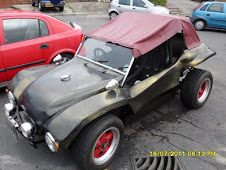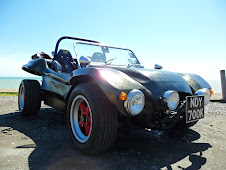 The fabrication of the Jig for locating the position of the IRS A-Frame brackets was not something I needed to do as I found a seller on www.volkszone.co.uk , who was wanting to sell the jig he had for building his own IRS. I picked up the jig from him and was soon aware that he had not used the conventional bolts that bolted the A-Frame in to position the brackets. The tubes that ran inside the brackets was only the size of a 1/2" UNC x 4" bolt. This did not give a steady position for the brackets and I decided that before using them I would have to check them against a real IRS chassis to ensure that they gave the correct position in practice. This would not be a problem as I new the location of a 1302s chassis that was bare at a friends workshop.
The fabrication of the Jig for locating the position of the IRS A-Frame brackets was not something I needed to do as I found a seller on www.volkszone.co.uk , who was wanting to sell the jig he had for building his own IRS. I picked up the jig from him and was soon aware that he had not used the conventional bolts that bolted the A-Frame in to position the brackets. The tubes that ran inside the brackets was only the size of a 1/2" UNC x 4" bolt. This did not give a steady position for the brackets and I decided that before using them I would have to check them against a real IRS chassis to ensure that they gave the correct position in practice. This would not be a problem as I new the location of a 1302s chassis that was bare at a friends workshop.I decided that I would not be able to fully position the brackets, but decided to clean up the frame horns and remove the surplus material along where the bracket would sit. Once I had the jig problems resolved I would be able to cut into the frame horn to get the final position of the bracket.
I started with the off side of the car removing the brake hydraulic lines that where still left. It was pretty clear at this point that my battery box was to low to gain access to the bracket position. I was also worried that being so low the A-arm would hit the bottom of the box as the suspension moved. This was not going to be an easy process with the body attached to the car, but I decided it looked feasible. I started by drilling a hole in the fibre glass that I could push the blade of a jig saw through. This allowed be to cut along the back and the inside of the battery box several inches from its bottom. I then managed to use an
 angle grinder to cut from the inside of the box the outside edge of the battery box. The angle grinder was also able to cut the box around the torsion bar, which enabled the bottom of the box to be removed.
angle grinder to cut from the inside of the box the outside edge of the battery box. The angle grinder was also able to cut the box around the torsion bar, which enabled the bottom of the box to be removed.With the bottom of the battery box removed I had access to the flange that ran along the outside of the off-side frame horn. I started to cut the metal with the angle grinder and cutting disk alongside the handbrake cable. I was able to cut the material back all the way to the torsion tube. When I had finished cutting this area out I switched to a grinding blade and cleaned the of the paint. I knew I would have to build a new floor to the battery box at a later date but I was pleased with the progress I had made with the drivers side.
The weather forecast for the next few days was awful and I was not able to get into the garage to cut the other side down. I had decided I wanted to cut the fibreglass on the nearside of the car , which was rumoured to be for a spare wheel. This was ludicrous of course as there was no way a beach buggy wheel would fit in this space.
The weather was suspected to get worse so this was all put on hold for better weather conditions that where more favourable as the high winds had nearly took the garage door off already.






















No comments:
Post a Comment